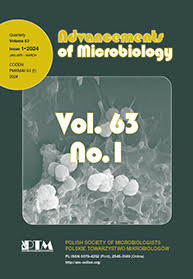1. Wprowadzenie. 2. Epidemiologia kandydoz. 3. Czynniki zjadliwości Candida albicans. 3.1. Adhezja. 3.2. Proteazy aspartylowe. 3.3. Pleomorfizm. 4. Leczenie zakażeń o etiologii Candida spp. 5. Nowe trendy w poszukiwaniu antymikotyków. 6. Podsumowanie
Abstract: Candida albicans normally exists as harmless commensal inhabiting mucosal surfaces of healthy individuals. Yet, this opportunistic pathogen in immunocompromised hosts causes superficial or invasive life treating infections with high mortality rate. The incidence of candidiasis appeared to have several predisposing factors such as immunosuppressant or steroids treatments, long-term catheterization, invasive medical procedures, treatment with broad-spectrum antibiotic, destruction of skin by deep skin burns, local disorders of the gastrointestinal tract, diabetes mellitus, premature very low birth weight infants, immunologically compromised individuals, spread of HIV infection. This serious problem causes a need for better understanding of C. albicans virulence and antifungal treatment. This review features characterization of chosen virulence factors i.e.: adhesion, pleomorphism and enzymatic activity. Currently natural antifungal substances as well as synthetic derivatives are used at broad scale in candidiasis treatment. Recently, an increase of resistance to antifungal agents commonly used in fungal infection management has been observed. This world-scale problem generated a need for a search for novel antifungals.
1. Introduction. 2. Epidemiology of candidiasis. 3. Virulence factors of Candida albicans. 3.1. Adhesion. 3.2. Secreted aspartyl proteases. 3.3. Pleomorphism. 4. Candidiasis management. 5. New trends in the search for novel antifungal agents. 6. Summary

